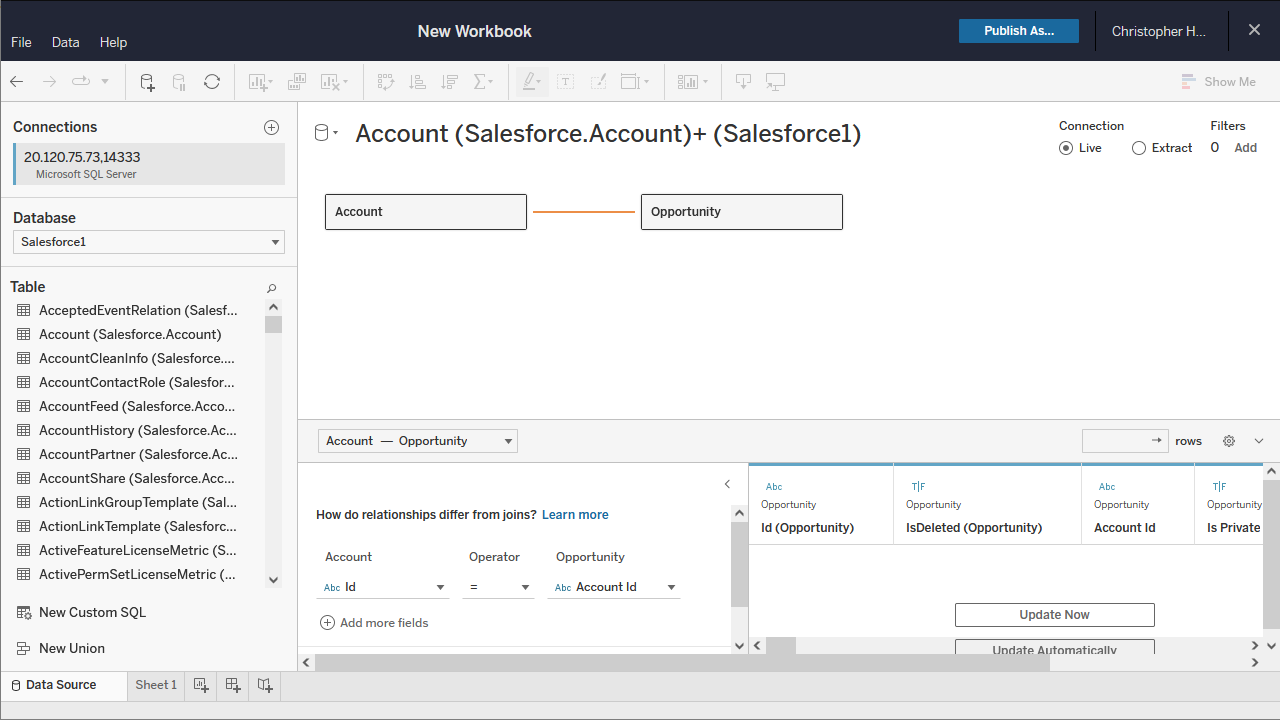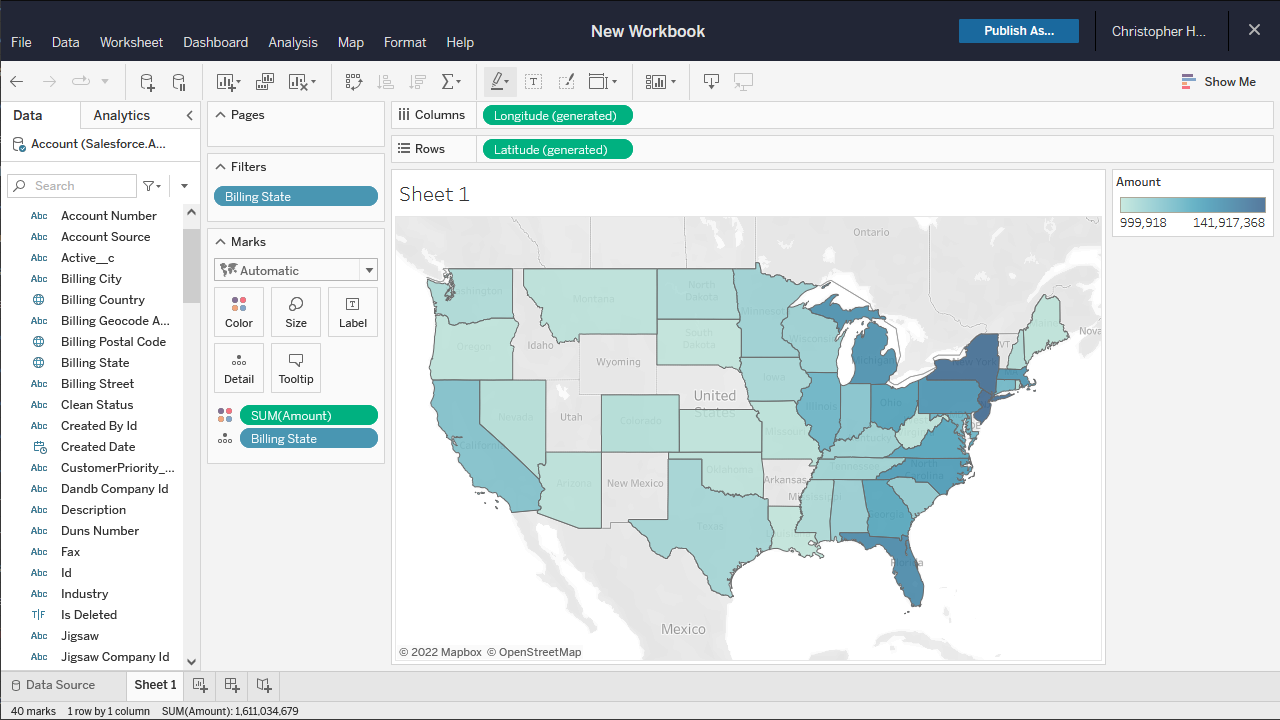Model Context Protocol (MCP) finally gives AI models a way to access the business data needed to make them really useful at work. CData MCP Servers have the depth and performance to make sure AI has access to all of the answers.
Try them now for free →Build MongoDB Visualizations in Tableau Cloud
Use CData Connect Cloud to connect to live MongoDB data and build visualizations in Tableau Cloud.
Tableau Cloud is an analytics platform fully hosted in the cloud. When paired with CData Connect Cloud, you get instant, cloud-to-cloud access to MongoDB data for visualizations, dashboards, and more. This article shows how to connect to MongoDB and build visualizations from MongoDB data in Tableau Cloud.
CData Connect Cloud provides a pure SQL Server, cloud-to-cloud interface for MongoDB, allowing you to easily build visualizations from live MongoDB data in Tableau Cloud without installing connectors or publishing worksheets and data sources from Tableau Desktop. As you build visualizations, Tableau Cloud generates SQL queries to gather data. Using optimized data processing out of the box, CData Connect Cloud pushes all supported SQL operations (filters, JOINs, etc) directly to MongoDB, leveraging server-side processing to quickly return MongoDB data.
About MongoDB Data Integration
Accessing and integrating live data from MongoDB has never been easier with CData. Customers rely on CData connectivity to:
- Access data from MongoDB 2.6 and above, ensuring broad usability across various MongoDB versions.
- Easily manage unstructured data thanks to flexible NoSQL (learn more here: Leading-Edge Drivers for NoSQL Integration).
- Leverage feature advantages over other NoSQL drivers and realize functional benefits when working with MongoDB data (learn more here: A Feature Comparison of Drivers for NoSQL).
MongoDB's flexibility means that it can be used as a transactional, operational, or analytical database. That means CData customers use our solutions to integrate their business data with MongoDB or integrate their MongoDB data with their data warehouse (or both). Customers also leverage our live connectivity options to analyze and report on MongoDB directly from their preferred tools, like Power BI and Tableau.
For more details on MongoDB use case and how CData enhances your MongoDB experience, check out our blog post: The Top 10 Real-World MongoDB Use Cases You Should Know in 2024.
Getting Started
About MongoDB Data Integration
Accessing and integrating live data from MongoDB has never been easier with CData. Customers rely on CData connectivity to:
- Access data from MongoDB 2.6 and above, ensuring broad usability across various MongoDB versions.
- Easily manage unstructured data thanks to flexible NoSQL (learn more here: Leading-Edge Drivers for NoSQL Integration).
- Leverage feature advantages over other NoSQL drivers and realize functional benefits when working with MongoDB data (learn more here: A Feature Comparison of Drivers for NoSQL).
MongoDB's flexibility means that it can be used as a transactional, operational, or analytical database. That means CData customers use our solutions to integrate their business data with MongoDB or integrate their MongoDB data with their data warehouse (or both). Customers also leverage our live connectivity options to analyze and report on MongoDB directly from their preferred tools, like Power BI and Tableau.
For more details on MongoDB use case and how CData enhances your MongoDB experience, check out our blog post: The Top 10 Real-World MongoDB Use Cases You Should Know in 2024.
Getting Started
Configure MongoDB Connectivity for Tableau Cloud
Connectivity to MongoDB from Tableau Cloud is made possible through CData Connect Cloud. To work with MongoDB data from Tableau Cloud, we start by creating and configuring a MongoDB connection.
- Log into Connect Cloud, click Connections and click Add Connection
![Adding a Connection]()
- Select "MongoDB" from the Add Connection panel
![Selecting a data source]()
-
Enter the necessary authentication properties to connect to MongoDB.
Set the Server, Database, User, and Password connection properties to connect to MongoDB. To access MongoDB collections as tables you can use automatic schema discovery or write your own schema definitions. Schemas are defined in .rsd files, which have a simple format. You can also execute free-form queries that are not tied to the schema.
![Configuring a connection (Salesforce is shown)]()
- Click Create & Test
- Navigate to the Permissions tab in the Add MongoDB Connection page and update the User-based permissions.
![Updating permissions]()
Add a Personal Access Token
If you are connecting from a service, application, platform, or framework that does not support OAuth authentication, you can create a Personal Access Token (PAT) to use for authentication. Best practices would dictate that you create a separate PAT for each service, to maintain granularity of access.
- Click on your username at the top right of the Connect Cloud app and click User Profile.
- On the User Profile page, scroll down to the Personal Access Tokens section and click Create PAT.
- Give your PAT a name and click Create.
![Creating a new PAT]()
- The personal access token is only visible at creation, so be sure to copy it and store it securely for future use.
With the connection configured, you are ready to connect to MongoDB data from Tableau Cloud.
Visualize Live MongoDB Data in Tableau Cloud
The steps below outline creating a new data source in Tableau Cloud based on the virtual MongoDB database in Connect Cloud and building a simple visualization from the data.
- Log into Tableau Cloud, select a account, and create a new workbook.
- In the new workbook, choose the Microsoft SQL Server Connector from the data wizard and fill in the values for your Connect Cloud instance.
- Set Server to tds.cdata.com,14333
- Set Database to the MongoDB connection you created (e.g. MongoDB1)
- Set Username to your Connect Cloud username (e.g. user@mydomain.com)
- Set Password to a PAT for the above user
- Check the Require SSL checkbox
![Connect to Connect Cloud from Tableau Cloud]()
- Select your newly created database and the table(s) you wish to visualize (defining relationships for JOINad tables as needed).
- Select Dimensions and Measures and configure your visualization.


Real-Time Access to MongoDB Data from Cloud Applications
At this point, you have a direct, cloud-to-cloud connection to live MongoDB data from your Tableau Cloud workbook. You can create new visualizations, build dashboards, and more, with no need to publish data sources and workbooks from Tableau Desktop. For more information on gaining live access to data from more than 100 SaaS, Big Data, and NoSQL sources from cloud applications like Tableau Cloud, refer to our Connect Cloud page.







